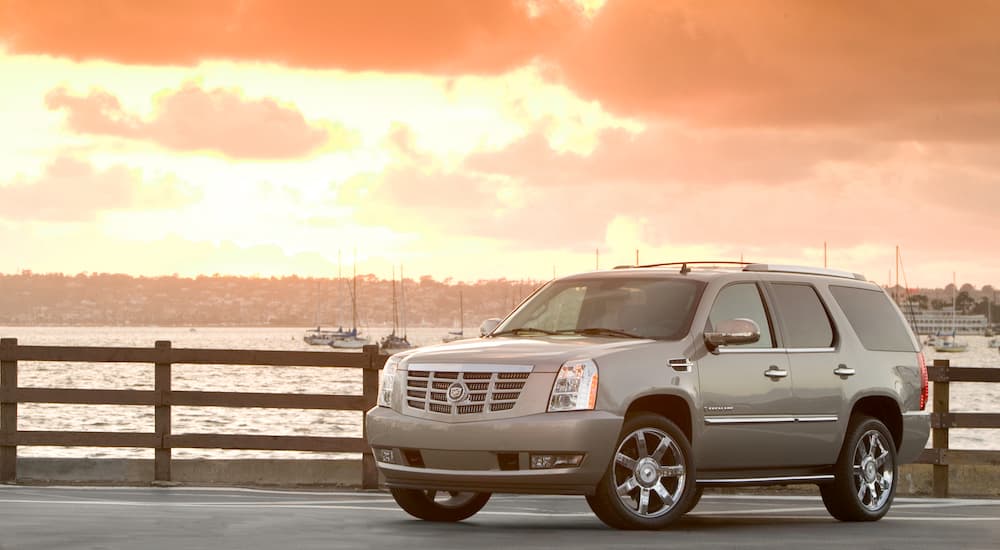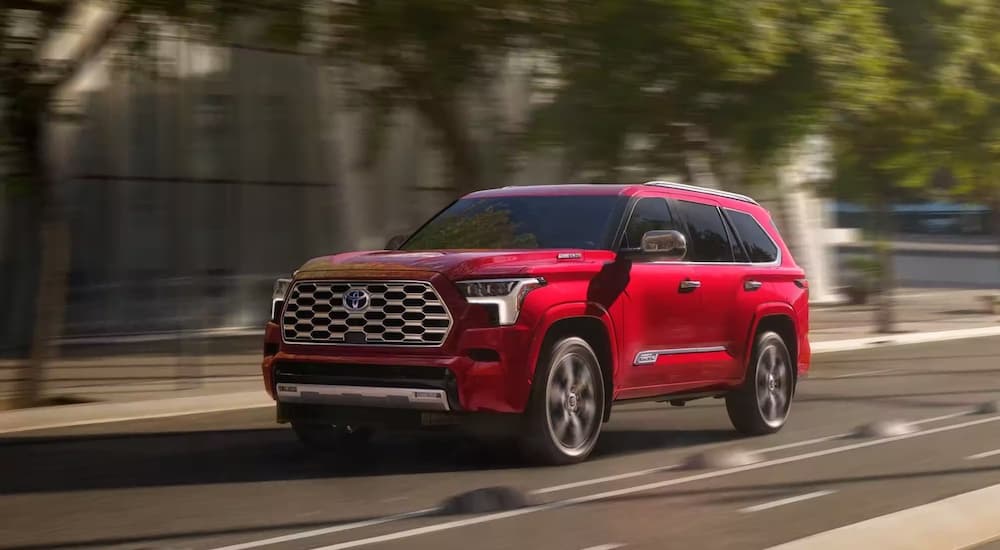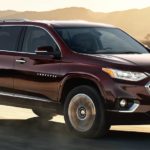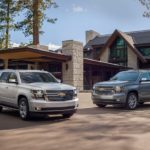The SUV has certainly come a long way. From the early days of the Toyota Land Cruiser and Ford Bronco to today’s subcompact and slimmed-down options, SUVs have become domesticated and made more accessible to the average driver. Visit any used car dealership, and you’ll be confronted with a wide variety of makes and models that seem to meet the needs of every single driver who might be shopping for an SUV. However, the late 1990s and early 2000s was an age when SUVs were not the consumer-friendly vehicles we know today but large beasts that took up enormous amounts of space and seem incredibly impractical when viewed with the benefit of hindsight. Come with us now as we turn back the hands of time to an era where giants roamed the highways, wild and unhindered.
#1 – Toyota Sequoia
The Toyota Sequoia is still in production, but its popularity has diminished in recent years. This once common family vehicle is now the favorite of a very niche audience. The concept of large and boisterous vehicles has usually been associated with domestic manufacturers such as Ford and Chevy, but the 2001 Sequoia is larger than the 2001 Chevy Tahoe. While the Sequoia is still the “big dog” of the Toyota SUV lineup, it’s not the largest SUV the brand has ever built. That distinction belongs to the Toyota Megacruiser, which was manufactured for military use in Japan during the late 1990s and bore a striking resemblance to the Hummer.
The Sequoia shows how automotive trends have drastically changed in the past two decades. Looking at any SUV in the modern era usually means having several different trims to compare and consider, and the modern Sequoia has five trims to choose from. However, the first generation of the Sequoia had only two: the SR5 and the Limited. But the biggest difference is in sales figures. To illustrate just how much the market has changed, 2002 saw over 70,000 Sequoias sold, compared to 2021, when this number plummeted to just over 8,000.

#2 – Cadillac Escalade EXT
As far as brand reputation is concerned, Cadillac has always been considered a status symbol among the social elite. Adored by the likes of Mary Kay and Elvis Presley when tail fins and whitewall tires were considered the most exquisite accessories, this tradition has been maintained by the GM brand. In the early 2000s, the ostentatious presentation of Cadillac was alive and well in the form of the Escalade EXT. Sharing its pickup truck bodystyle with the Chevy Avalanche, the Escalade EXT had a brief stint of popularity. Many hip-hop music videos featured the vehicle prominently, and it briefly served as a symbol of luxury and decadence.
A V8 engine and stylish interior were the hallmarks of the vehicle––aside from the unique style that made it a novelty among the many SUVs that were beginning to gain traction at the time. While nostalgic car buffs tend to look back at the Chevy Avalanche with fondness and appreciation, the same can’t be said for the Escalade EXT. The best way to describe its cultural relevance would be “blink, and you miss it.” Despite selling over 13,000 units in 2002, its decline in popularity was rapid enough to make one’s head spin. In 2010, slightly more than 2,000 units left dealership lots, and sales never recovered before the vehicle was discontinued in 2013. Had it not been for the brief surge of popularity at its release, this full-sized SUV might have had the same reputation as the Edsel as a marketing blunder.
#3 – Ford Excursion
Of course, we couldn’t possibly mention the days of SUV hubris without mentioning the Ford Excursion. If the concept behind SUVs in the late 1990s and early 2000s was “bigger is better,” then the Ford Excursion is that theory fully realized and manifested within a single vehicle. Arriving in 2000, the Excursion still holds the unique distinction of being the largest and heaviest SUV ever produced.
Built on the chassis of the Ford F-250 Super Duty pickup truck, the Excursion featured powertrains designed to propel the large vehicle forward while complying with low-emission vehicle status. A 5.4L V8 and 6.8L V10 were available during the vehicle’s short production run, as was a 7.3L diesel engine, which was replaced in the final phase of production by a smaller but more powerful 6.0L diesel. Naturally, the massive Excursion was notorious for its poor fuel economy.
Similar to the Cadillac Escalade EXT, the Ford Excursion had a brief surge of popularity before rising gas prices in the early 2000s caused this behemoth to fade away. Although over 50,000 units were sold in 2000, the Excursion’s popularity fell steadily over the following years. By the 2005 model year, the last year of production, barely 16,000 units were sold. While it’s easy to see the Excursion as nothing more than a product of hubris and a very different time in the automotive industry, it represents ambition from a manufacturer that took the SUV to the absolute limit.
#4 – AM General Hummer H1
If the Cadillac Escalade EXT was thought of as a status symbol for a few fleeting moments, then the Hummer H1 was the ultimate symbol of disposable income. After the military’s new HMMWV (commonly pronounced “Humvee”) entered the public eye during the Gulf War, many people wanted to experience this grandiose example of engineering for themselves. As a result, 1992 would see the vehicle being made available for civilian use. The Hummer H1, in many respects, was way ahead of its time, combining the attributes of an SUV with unbeatable off-road performance. With 16 inches of ground clearance and the ability to ford 30 inches of water, the Hummer H1 compares favorably with modern off-roaders like the Jeep Wrangler and Ford Bronco.
The Hummer H1 would eventually end its production run in 2006, with just under 12,000 units sold during its 15 years on the market. Similar to the Excursion, the Hummer H1 proved impractical, with changes in the economy and the need for smaller SUVs eventually ending its reign. Its abysmal efficiency meant that the cost of fuel alone was far beyond the means of the average consumer. While the Hummer nameplate has continued to exist in one form or another, the vehicle’s initial run remains one of the best examples of a vehicle that existed for a very niche audience.
Nostalgia for a Bygone Era
There’s something about looking at vehicle trends from the past that are no longer in vogue, be it the muscle cars of the 1960s or the larger-than-life SUVs of the 1990s and early 2000s. While many designs have long left the public eye and are relegated to the memories of automotive enthusiasts, there’s something undeniably enjoyable in looking back at where the SUV once was and where it is now. With more and more SUVs becoming equipped with batteries and electric motors, the days of large gas and diesel powertrains might go the way of tailfins and whitewall tires. Still, it’s always entertaining to have a look back.




